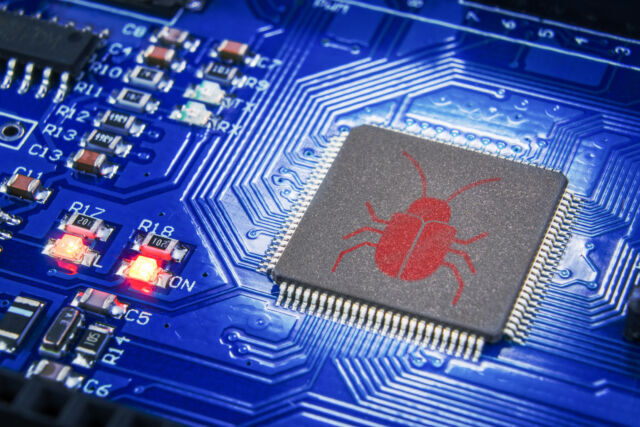#SchiffsSamstag #ShipSaturday #IrischeSee #MôrIwerddon #Meer #sea #ocean #beach #Strand #Schiff #Boot #ship #boat #fishingBoat #Fischerboot #SeaWednesday #WaterWednesday #PenrhynLlŷn #PenLlŷn #LlŷnPeninsula #Porthdinllaen #Nefyn #NorthWales #Wales #Cymru #UK
#boot
#SchiffsSamstag #ShipSaturday #IrischeSee #MôrIwerddon #Meer #sea #ocean #beach #Strand #Schiff #Boot #ship #boat #fishingBoat #Fischerboot #SeaWednesday #WaterWednesday #PenrhynLlŷn #PenLlŷn #LlŷnPeninsula #Porthdinllaen #Nefyn #NorthWales #Wales #Cymru #UK
Angebliche "Drogenterroristen": USA attackieren erneut Boot vor Venezuela
Die USA haben vor der Küste Venezuelas erneut ein Boot mutmaßlicher Drogenschmuggler angegriffen und laut Kriegsminister Hegseth vier Menschen getötet. Mehrere Drogenkartelle wurden als "Terrororganisationen" eingestuft.

Have fun with your devices after 11th September 2025 (MS 9/11)
https://fwupd.github.io/libfwupdplugin/uefi-db.html
Hackers are targeting pre-OS environments like UEFI, bypassing kernel protections and staying hidden, Eclypsium warns.
#hack #cybersecurity #boot #cyberthreat
https://cnews.link/hackers-targeting-uefi-bios-bootloaders-1/
I have a relatively new laptop. Recently when rebooting it just went to the GRUB bash-like interface rather than booting.
99 times out of 100 when rebooting the laptop doesn't recognize any USB key is plugged in and goes straight to GRUB recovery. #EFI boot sees the drives EFI files though.
1 in 100 times the whole thing boots just fine from either the drive or USB key.
BIOS hard drive diagnostics says it's fine.
Any ideas how to troubleshoot?
One of the hashtags _guru
Im #Bartolomeo gab es daneben auch eine #Marina mit der Möglichkeit ein #Boot zu mieten. Wir sind hier häufiger Mal zum Essen gewesen, unter anderem zu meinem Geburtstag im Januar 2019. Dieses Bild stammt vom August 2021, als wir dort unseren #Hochzeitstag gefeiert haben, mit Übernachtung./4 #Dnipro #Heimat #Heimatland #Ukraine #angriffskrieg
Starting with snapshot 20250211, #SELinux becomes the default #MAC system for new installs, boosting security! #AppArmor is still optional. The first #boot might take a little time. #openSUSE #Tumbleweed https://news.opensuse.org/2025/02/13/tw-plans-to-adopt-selinux-as-default/

#DemoGegenRechts im #Kanu #Kajak und #Ruderboot - Erste Kölner #RheinDemo am 2.2.2025
Bunt statt Braun - auf's Wasser für #Demokratie und #Vielfalt
Start um 13:00 an der Südbrücke
Zwischenkundgebung am Deutzer Hafen
Ende an der Zoobrücke
Wer auf dem #Rhein mitmachen möchte, braucht für die anspruchsvolle Strecke genügend Erfahrung, aber auch ohne #Boot freut sich die RheinDemo über bunte und laute Unterstützung vom Ufer und am Deutzer Hafen.
https://wsf-neptun-koeln.de/bunt-statt-braun-demonstration-fuer-demokratie-und-vielfalt
#Köln #Paddeln #Rudern
Friends, thank you very much for all your suggestions. I will look at them all more closely. I will try different things. You have been exhaustive in your suggestions, and I will discover quite a few things by exploring these solutions. :0)
@RandamuMaki
@laale
@benjamineskola
@Cal
@airtower
@josch
@1eye
I will respond individually. :0)
Have a fantastic weekend!
The (full) story started here..
https://mastodon.cloud/@WoodooProd/113700878081896933

Just wanted to know if Debian 12.08 could run on this little Samsung N210 Machine.
It works well! But.. I really need to find a Linux distrib running fast with only 2 Go of Ram.
Any ideas/suggestions?
Are very welcome! :0)
As you see I've been able to install all the 3 system in a multiboot working.
Ok, do we boot?
Understanding UEFI: How It Works and Its Internals
The Unified Extensible Firmware Interface (UEFI) is a modern firmware interface between a computer's operating system and its hardware. Designed to overcome the limitations of the older BIOS (Basic Input/Output System), UEFI offers enhanced functionality, improved performance, and better security. Here’s a comprehensive look at how UEFI works and its internals.
Read More: https://machaddr.substack.com/p/understanding-uefi-how-it-works-and
#Ventoy Security Concerns (please boost for visibility)
Ventoy is a popular utility for making USB drives containing multiple operating systems in the form of bootable image files. While very useful in theory, the source tree contains numerous binary blobs without source code. This issue has been brought up to the authors multiple times, have not been corrected, and have even gotten worse (more blobs have been added to the code over time). This is a potential malware vector, similar to the "test files" in the xz-utils backdoor catastrophe.
Recently the author has ignored a very lengthy thread raising security concerns because of these binary blobs. Given the amount of attention the thread has gotten, this seems strange, especially given that the authors have been active since then. https://github.com/ventoy/Ventoy/issues/2795
Stranger yet still, a video by Veronica Explains (@vkc) on how to create bootable USB flash drives got flooded by comments heavily suggesting the use of Ventoy and even being somewhat accusing because Veronica didn't advertise Ventoy. This is... not anything I've seen users of ANY open-source project do, and it feels similar to the social engineering done against Lasse Collin that convinced him to add Jia Tan as a maintainer, thus compromising xz-utils. See the comments of https://www.youtube.com/watch?v=QiSXClZauXA&t=3s
If you're using Ventoy, you may want to consider ceasing its use for the time being out of an abundance of caution. If you truly need its functionality, you might look into something like the IODD SSD Enclosure (https://www.iodd.shop/HDD/SSD-Enclosure) which can emulate an optical drive and allows you to select an ISO saved to the drive to boot from.

“It’s a big problem,” said Martin Smolár,
a malware analyst specializing in rootkits
who reviewed the Binarly research and spoke to me about it.
“It’s basically an unlimited Secure Boot bypass for these devices that use this platform key.
So until device manufacturers or OEMs provide firmware updates, anyone can basically… execute any malware or untrusted code during system boot.
Of course, privileged access is required, but that’s not a problem in many cases.”
Binarly researchers said their scans of firmware images uncovered 215 devices that use the compromised key,
which can be identified by the certificate serial number
55:fb:ef:87:81:23:00:84:47:17:0b:b3:cd:87:3a:f4.
A table appearing at the end of this article lists each one.
The researchers soon discovered that the compromise of the key was just the beginning of a much bigger supply-chain breakdown
that raises serious doubts about the integrity of Secure Boot
on more than 300 additional device models
from virtually all major device manufacturers.
As is the case with the platform key compromised in the 2022 GitHub leak,
an additional 21 platform keys contain the strings “DO NOT SHIP” or “DO NOT TRUST.”

In 2012, an industry-wide coalition of hardware and software makers adopted #Secure #Boot to protect against a long-looming security threat.
The threat was the specter of malware that could infect the BIOS,
the firmware that loaded the operating system each time a computer booted up.
From there, it could remain immune to detection and removal and could load even before the OS and security apps did.
The threat of such BIOS-dwelling malware was largely theoretical and fueled in large part by the creation of ICLord Bioskit by a Chinese researcher in 2007.
ICLord was a #rootkit, a class of malware that gains and maintains stealthy root access by subverting key protections built into the operating system.
The proof of concept demonstrated that such BIOS rootkits weren't only feasible;
they were also powerful.
In 2011, the threat became a reality with the discovery of #Mebromi, the first-known BIOS rootkit to be used in the wild.
Keenly aware of Mebromi and its potential for a devastating new class of attack,
the Secure Boot architects hashed out a complex new way to shore up security in the pre-boot environment.
Built into #UEFI
—the Unified Extensible Firmware Interface that would become the successor to BIOS
—Secure Boot used public-key cryptography to block the loading of any code that wasn’t signed with a pre-approved digital signature.
To this day, key players in security
—among them Microsoft and the US National Security Agency
—regard Secure Boot as an important, if not essential, foundation of trust in securing devices in some of the most critical environments, including in industrial control and enterprise networks.
An unlimited Secure Boot bypassOn Thursday, researchers from security firm Binarly revealed that
Secure Boot is completely compromised
on more than 200 device models
sold by Acer, Dell, Gigabyte, Intel, and Supermicro.
The cause: a cryptographic key underpinning Secure Boot on those models that was compromised in 2022.
In a public GitHub repository committed in December of that year, someone working for multiple US-based device manufacturers published what’s known as a #platform #key,
the cryptographic key that forms the root-of-trust anchor between the hardware device and the firmware that runs on it.
The repository was located at github.com/raywu-aaeon/Ryzen2000_4000.git,
and it's not clear when it was taken down.
The repository included the private portion of the platform key in encrypted form.
The encrypted file, however, was protected by a four-character password,
a decision that made it trivial for Binarly, and anyone else with even a passing curiosity, to crack the passcode and retrieve the corresponding plain text.
The disclosure of the key went largely unnoticed until January 2023,
when Binarly researchers found it while investigating a supply-chain incident.
Now that the leak has come to light, security experts say it effectively torpedoes the security assurances offered by Secure Boot.

@AlisonCreekside It is painful to watch these guys brazenly lie to the media when there is so much at stake right now.
Your post contains the Cons entire media strategy ..
#NonAnswer
#secret
#boot
#silence
#actDumb
Sorry for the delays but I've had to work on some things that prevented me from working on @OS1337 ...
https://github.com/OS-1337
I've had to basically fork the #mlb #bootloader because it is basically unmaintained...
...after all #syslinux wastes ~ 200kB of space...
Now this is kind of a mess but I've to sort this out...
On the flipside I did build mlb so everyone can just yoink it for their minimalist distro needs...

UPDATE: SOLVED!
https://github.com/OS-1337/OS1337/issues/2



#FollowerPower: Anyone with #Linux - #boot|ing #KnowHow able and willing to take a look why my current build of OS/1337 doesn't boot?
It's a 1440kB 3,5" #Floppy image and should work just fine in #VirtualBox / #QEMU / #KVM / #vmware but it's stuck after loading #Linux (bzImage) and the remaining files (rootfs.cpio.xz)...
It uses #syslinux as #bootloader so any hints are appreciated.




